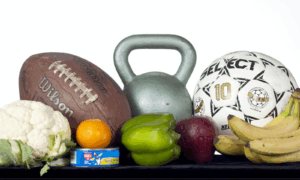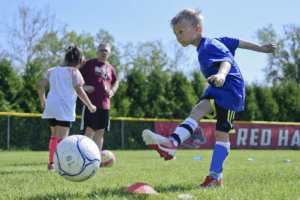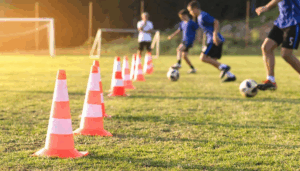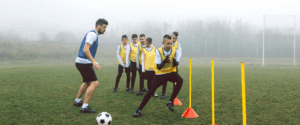Soccer is one of the most popular youth sports in Canada, and for good reason. It is accessible, affordable, and a great way for kids to stay active. Parents love it because it builds teamwork and discipline. Kids love it because it is fun. But along with the excitement comes a worry that almost every parent has at some point: what about injuries?
The truth is that injuries do happen in youth soccer. The good news is that most of them can be prevented with the right awareness and preparation. If you are a parent, coach, or even just a curious supporter, understanding soccer injury prevention is one of the best ways to keep young players safe on the field.
Why Injuries Happen in Youth Soccer
Think about the nature of the sport. Soccer involves a lot of running, cutting, jumping, and sudden changes in direction. Those movements are tough on growing bodies. Common injuries in young players include sprained ankles, pulled muscles, and knee problems. More serious concerns, like concussions or ligament tears, are less frequent but still possible.
The risk is higher in competitive environments where kids play hard, sometimes year-round, without enough rest. Fatigue, poor technique, and lack of proper warm-up routines can all turn a normal play into an injury.
What the Research Says
You are not just imagining it: youth soccer injuries are a documented concern. A recent study published on PubMed found that soccer consistently ranks among the top sports for injury rates in young athletes. The research highlights not only the frequency of injuries but also the importance of structured prevention programs.
For Canadian families, this is an important reminder. Youth sports safety should not only focus on performance but also on building habits that reduce risk. Prevention matters just as much as competition.
Building a Strong Foundation: Training and Technique
One of the best strategies for football injury prevention in Canada is simply teaching young players the basics of movement. This means:
- Proper warm-ups and cool-downs: A five-minute jog and some quick stretches are not enough. Kids need dynamic movements before playing, like lunges, skipping drills, and agility exercises. Cooling down afterward helps muscles recover.
- Strength training: Age-appropriate strength work, such as bodyweight squats or resistance bands, builds stability in knees and ankles. This makes sudden pivots and jumps less risky.
- Technique focus: Coaches should emphasize correct form for kicking, landing, and tackling. Repetition of safe movements lowers the chance of bad habits that lead to injury.
Parents sometimes worry that strength or agility training is too much for kids. The reality is that when done properly, it protects them. The goal is not bodybuilding, it is stability and injury prevention.
Rest and Recovery: The Overlooked Factor
A lot of young athletes want to play year-round. While that enthusiasm is wonderful, their bodies still need breaks. Rest days and off-seasons are not a sign of weakness, they are essential. Overuse injuries, like shin splints or stress fractures, often come from doing too much without recovery time.
Encourage your child to play more than one sport or to take a break after a long soccer season. Variety helps their body develop evenly, which actually makes them stronger players in the long run.
Gear and Field Safety
Injury prevention is not just about the body, it is also about the environment.
- Footwear: Make sure cleats fit properly and match the type of field (indoor, outdoor, turf, or grass). Shoes that are too loose or too tight create unnecessary strain.
- Shin guards: These are non-negotiable. They protect against impact and reduce the severity of collisions.
- Field conditions: Uneven ground, poor lighting, or cluttered sidelines are hazards. Parents and coaches should do quick checks before games and practices.
It may seem small, but the right gear and a safe field go a long way in keeping kids safe.
Mental Preparation Matters Too
Soccer injury prevention is not only physical. A child who feels pressure to play through pain is at higher risk. Kids need to know it is okay to speak up if something hurts. Coaches and parents should encourage open conversations about discomfort or fatigue.
Sports culture sometimes glorifies toughness, but ignoring pain often leads to bigger problems later. Teaching children to listen to their bodies is one of the most valuable lessons they can carry into adulthood.
The Role of Parents and Coaches
Both parents and coaches play a big part in youth sports safety. Parents can support by making sure kids show up rested, hydrated, and fueled with healthy food. Coaches can design practices that balance skill development with injury prevention drills.
The partnership matters. When parents and coaches communicate openly about a player’s workload, injuries are less likely to be ignored or hidden.
Looking at the Bigger Picture
At the end of the day, soccer should be fun. Injury prevention is not about scaring kids away from the sport. It is about making sure they can enjoy it for years without unnecessary setbacks. In Canada, where soccer continues to grow in popularity, conversations around football injury prevention are becoming more common. That is a positive sign that we are moving in the right direction.
If parents, coaches, and players commit to the basics – proper training, rest, safe gear, and open communication – youth soccer can remain a safe, healthy way for kids to grow, compete, and connect.
Final Thoughts
Soccer injury prevention starts with awareness. Once you know the risks, it becomes easier to take steps that keep kids safe. Parents do not need to be experts in sports medicine, but they do need to ask questions, advocate for rest, and support safe training habits. Coaches do not need fancy equipment, but they do need to model proper technique and listen when a child says something feels wrong.
Youth sports safety is about balance. Push kids enough to grow, but protect them enough so they can keep playing the game they love. That balance is what keeps children safe on the field today and prepared for a lifetime of healthy activity tomorrow.





